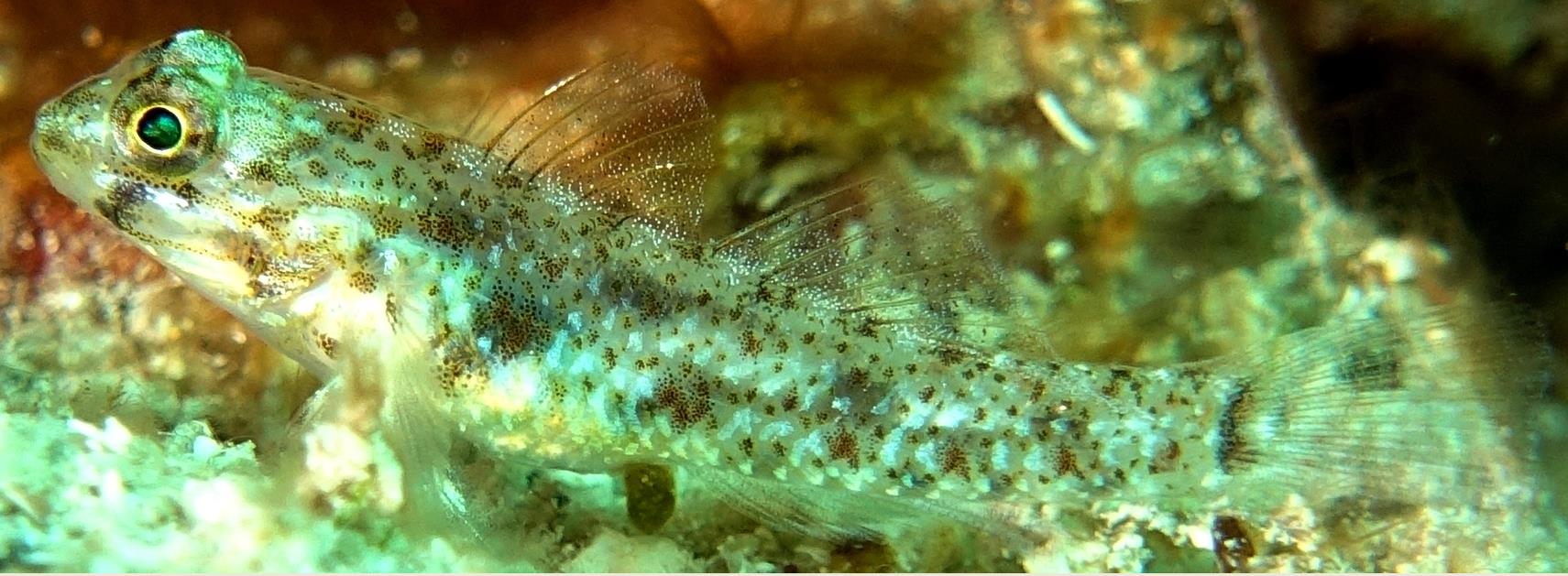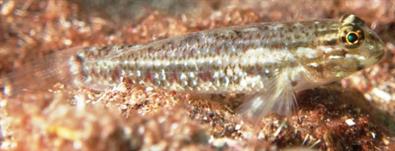



Coryphopterus dicrus
| Ecological Descriptors |
||||
| Habitat | Size (cm) | Diet | Behaviour | Sex |
| Co, R | 5 | Cru, Wor | I | PGH |
Description:
White to tan translucent body. Body with numerous small dark spots and flecks (can include onto dorsal fin). Irregular rows of round spots on nape. 2 dark spots ("colon punctuation mark) at base of pectoral fin - though upper one may be absent. White streak from base of pectoral fin extends towards outer edge of of fin. usually a dark bar, or 2 dusky spots loosely connected by narrow bar at base of caudal peduncle/ start of tail.
Ecology
Shallow water from 1-12m (3-40ft). It inhabits coral reefs, tide pools, limestone caves, algae-covered rocks and isolated patch reefs surrounded by white sand. It is solitary species that feeds on benthic invertebrates.
Life Cycle:
Species of this genus are sequential protogynous hermaphodites, maturing as females and later changing sex to male. An average of 825 eggs are deposited on hard substrate by the female and fertilized by the male. Courtship and spawning behaviour in captivity have been described, however, its longevity is not yet known
Proxy (surrogate) life history data (! N.B.!) based on a study of Coryphopterus kuna: Larvae settle around 7-9 mm, adults mature at 10-11 mm SL and then only attain about 17 mm. It has a 60-day pelagic larval life and matures rapidly. They are sexually active in as few as three weeks and live for about two months after settlement. This is the first reported fish in which the pelagic larval duration is generally longer than the post-settlement lifespan, which indicates that C. kuna may represent the extreme of a bipartite life-history strategy: a relatively slow-growing pelagic larval stage, often with delayed metamorphosis, in combination with a rapidly maturing, high-mortality adult stage. Based on this information, it is inferred that three generation lengths are almost certainly no more than ten years.
White to tan translucent body. Body with numerous small dark spots and flecks (can include onto dorsal fin). Irregular rows of round spots on nape. 2 dark spots ("colon punctuation mark) at base of pectoral fin - though upper one may be absent. White streak from base of pectoral fin extends towards outer edge of of fin. usually a dark bar, or 2 dusky spots loosely connected by narrow bar at base of caudal peduncle/ start of tail.
Ecology
Shallow water from 1-12m (3-40ft). It inhabits coral reefs, tide pools, limestone caves, algae-covered rocks and isolated patch reefs surrounded by white sand. It is solitary species that feeds on benthic invertebrates.
Life Cycle:
Species of this genus are sequential protogynous hermaphodites, maturing as females and later changing sex to male. An average of 825 eggs are deposited on hard substrate by the female and fertilized by the male. Courtship and spawning behaviour in captivity have been described, however, its longevity is not yet known
Proxy (surrogate) life history data (! N.B.!) based on a study of Coryphopterus kuna: Larvae settle around 7-9 mm, adults mature at 10-11 mm SL and then only attain about 17 mm. It has a 60-day pelagic larval life and matures rapidly. They are sexually active in as few as three weeks and live for about two months after settlement. This is the first reported fish in which the pelagic larval duration is generally longer than the post-settlement lifespan, which indicates that C. kuna may represent the extreme of a bipartite life-history strategy: a relatively slow-growing pelagic larval stage, often with delayed metamorphosis, in combination with a rapidly maturing, high-mortality adult stage. Based on this information, it is inferred that three generation lengths are almost certainly no more than ten years.
Colon Goby


Colon Goby
See comparative table and images of various Sand Gobies (Coryphopterus spp) HERE




330



321



